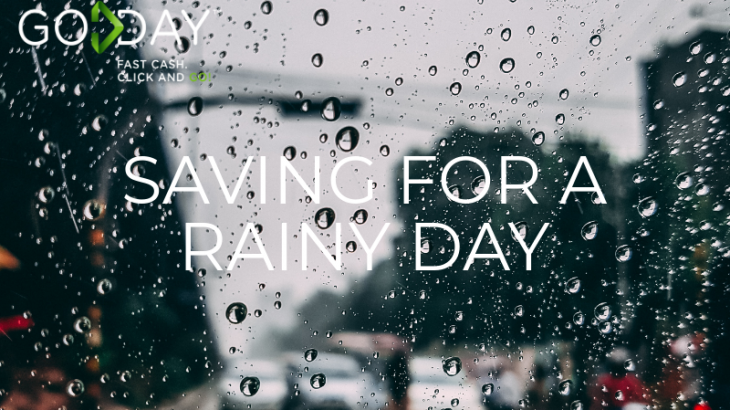

The money you hope you’ll never need to use. The “rainy day fund” is the popular term used for the money you’ve saved that may need to be used when a disaster strikes. While you can’t plan for the unexpected, you can take a bit of salt off the wound by ensuring your financially prepared for it.
Your rainy day fund is a savings of money that will help prepare you for the future if you ever come across an unexpected expense. This could be anything and everything. For example, a broken appliance, car repairs, a medical emergency, and the list goes on.
You’re probably wondering how you save for something when you don’t really know what you’re saving for. Having a viewpoint on a rainy day fund like this can make saving hard because there’s probably a million other things you’re also saving up for like retirement, that dream vacay, a new house or car, however, you never know what your life path has planned for you and it’s better to be safe than sorry.
These tips will help make sure you are on the right foot, and prepared if something strikes yourself or family that you may need extra money to take care of.
Understand its purpose
Defining early on what your rainy day fund is will help you set the right mentality for it. The savings is for the unexpected, not your personal wants or needs, and it shouldn’t be as hard to access as a retirement savings account for example. These savings will typically be between $1000-$5000, and they’ll differ from what you may look at as your emergency fund. Why? Because an emergency fund will likely have more savings in it ($10K-$15K) and is created to keep you afloat for a few months if say for example you lose your job. A Rainy day fund will be for smaller but unexpected expenses.
If you’re someone living paycheck to paycheck, you’re probably wondering how on earth you’re supposed to save for two different funds. Therefore it’s more likely that you’ll have your rainy day fund before your emergency fund since it’s more of a digestible goal.
Select your savings account
There are so many different types of savings accounts out there that each bank offers, and it’s important to find the right one that works for you. Some examples are:
Tax Free Savings Account: An account where you can take out what you put in with no penalty. These are great to easily access your funds but may be too easily accessible to you when you’re trying to save. Your money that is sitting in the account also won’t grow while it sits there.
No-Fee Savings Account: Check your bank for an account that won’t have any fees. You want to save the money, and not have fees coming off of the amount you save each month.
Mutual Funds or Retirement Savings Plans: These can be a great way to grow your money while it’s sitting there, however, it can be challenging to take money out of these accounts if an emergency or unexpected event strikes.
There are a ton of different options out there, make sure to take to your bank and/or financial advisor to see what makes the most sense for this particular kind of savings. You’ll want to ensure your rainy day fund is in the right account for you, and an account that isn’t too easily accessible where you can easily spend your savings on just anything, but also isn’t too hard to access if an unplanned expense strikes.
Bank any extra income
Getting a raise or promotion? Did you pick-up a side gig or start a new project that’s bringing in a few extra dollars each month? Get a great tax return this year? It feels great to have an extra income, however, instead of blowing it on things you don’t need, or increasing your spending habits, stash at least some of this extra money away for savings.
Any time you get a raise at work, figure out what percentage of that raise you can put in your savings. If you can, put 100% of it into your savings. You already were living perfectly fine on what you were making before after all. The best part of this is that you are beefing up your rainy day fund while not having to sacrifice or change your day-to-day cash flow that you’re used to, and you won’t be running to get fast payday loans in Canada to get you through.
Keep your accounts separate
We cannot stress enough how important this is to saving money. Keep your saving separate from your regular spending account. Also, keep it separate from other savings you have. For example, your retirement savings shouldn’t be mixed with your rainy day fund, or your savings for that dream car, shouldn’t be mixed with an emergency fund. Otherwise things get to intertwined, and it’s easy to accidentally (or justify) taking money for something else.
The best and easiest way to save is to keep things separate and not too easily accessible that you can access that money in your day-to-day, but of course, not so inaccessible that if you need to pay for something with your rainy day fund you can access it.
Set a monthly savings goal
Setting a goal for how much you want to save in your rainy day fund will help be a major motivator to get yourself there. Then, to make it seem more achievable, set out smaller goals to help you achieve that overall goal. For example, figure out exactly how much you can put into your rainy day fund every paycheck, and automatically have these payments come off of your paycheck and into your savings account. It’s amazing how quickly you’ll learn how to live with less, you’ll also not even notice the money going into that account each pay day, and suddenly you’ll have reached your savings goal.
We recently did a post on setting your financial goals which will be helpful for creating your overall financial goals, as well as your savings goal. However, the key steps to take when trying to come up with a number for your monthly savings goal is to:
1. Set a budget or take a look at your budget
If you don’t already have a budget, it’s time to make one. If you do, it’s time to look at where your money is going and how much you have to allocate to putting into your rainy day fund monthly, or bi-weekly.
2. Stay organized
Stay on top of your savings and spending by tracking where your money is going and ensuring that no matter what, your regular contribution to your fund always happens. Sometimes this may mean cutting your spending in another category (see our savings tips at the bottom of this post to get ideas on how you can do that).
3. Figure out how long it’ll take you to reach your goal
Sometimes seeing this number may seem daunting, but it can also be encouraging for you to try and contribute more, especially if you have a month where you find yourself with some extra income.
Write it down
If you have a goal for your savings or monthly budget in your head, you NEED to write it down. Having something written down helps you stick to it more, and holds you accountable. Most people who aren’t working towards a specific savings goal, don’t have a goal at all, and this can be the biggest mistake as you won’t see a light at the end of the tunnel as you add money to your account. Lay out your overall goal, and your smaller goals, and have them somewhere you can constantly refer to or be reminded of them.
Saving for a rainy day isn’t the most exciting thing to save for, however, if something does happen that requires a chunk of money, you’ll be happy you don’t have to dig into your retirement savings or go into debt in order to make ends meet. Being proactive and prepared will be worth it in the long run. Here are a few bonus tips to help you stop spending money on useless things so you can add that money into your savings:
Stash spare change
Seriously though, don’t keep it in your wallet, throw it into a jar, you’d be amazing at how quickly this can add up.
Stop buying your morning coffee
A simple habit that can save you hundreds of dollars. Buy yourself a travel mug, and start making your own coffee.
Give up the bad habits
Have you ever taken a look at how much those cigarettes are costing you in a month?
Resell what you don’t use
There are a ton of websites out there that help you sell off those things you no longer need. One person’s junk is another person’s treasure.
Collect rewards
Make sure you have the best credit and debit cards that are giving you rewards that you can use such as travel points or cash back.
Stop eating out
Meal prep on Sunday’s your lunches for the week, and get inspired by recipes on Pinterest. Stop eating out every meal!
Use apps
Apps like Checkout51 and GasBuddy can help you save money on groceries and gas. There’s also a ton of other apps out there that can help you find the best deals.
The 30-day rule
If there is something you want to buy (not need), give it 30-days before you bite the bullet. This helps with impulse shopping and often after 30-days you’ve completely forgot about the item anyway.
Create a budget
It all starts with a budget. Write it down and take a look at all your expenses then lay out a budget to stick to each month.
Unsubscribe
Take a look at the services you have that you pay into that you may not fully use. Reevaluate if there’s a cheaper cell phone or internet plan, and see if you can live without cable.
Find cheap entertainment
Instead of going out for dinner, have your friends over for a potluck. Instead of buying new books, head to your local library. There are so many ways you can cut costs when it comes to entertainment without being bored.
Throw a clothing swap
Invite all your friends for a clothing swap and clean out your closet. Each friend will bring their bag of unwanted goods and you can all go through it, and swap. What they don’t want may be something you love.
Stick to water
Water is free in most places, opt for it instead of drinking pops or alcohol.
Carpool
Carpool with someone to work everyday, or look into more cost efficient ways to get to point a and point b. Sometimes it’s easier to just walk.
Saving for a rainy day is important for your financial planning. How do you save money for a rainy day? Share your tips with us!



